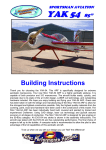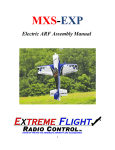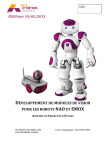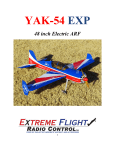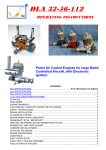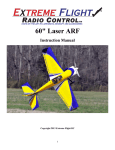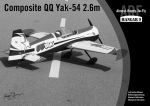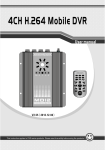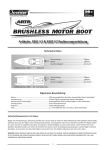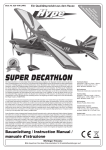Download SUPER DECATHLON
Transcript
S U P E R DE CAT H L O N Thank you for choosing the Super Decathlon. With this model you can truly enjoy the feeling and grace of flying. The (49in) wing span has a “Clark-Y” type airfoil section which makes it easy to fly, yet will perform a wide variety of aerobatic maneuvers with ease. When the Citabria Decathlon was introduced, it was the only airplane being commercially produced in the United States which was certified for aerobatics. From the mid 1960s through the end of the 1970s, sport flying in the United States enjoyed great popularity. Pilots who flew for personal enjoyment were interested in the unusual and exciting, and aerobatics provided an avenue for this interest. They were popular as trainers—because of their conventional gear and their aerobatic capabilities—and as personal aircraft. They were also found in utility roles such as bush flying—thanks to their short take off and landing ability, agriculture, pipeline patrol, and as glider tow planes. Though variants of the design, and other better-suited designs, have largely taken over the Citabria's utility roles, they still remain popular as trainers, glider tow planes, and for personal use. Performance General characteristics • • • • • • • • • Length: 22 ft 9 in (6.9 m) Wingspan: 33 ft 5 in (10.2 m) Height: 6 ft 9 in (2.4 m) Wing area: 165 ft² (15.3 m²) Airfoil: NACA 4412 Empty weight: 1,110 lb (503.5 kg) Loaded weight: 1,650 lb (748 kg) Useful load: 540 lb (244.5 kg) Max takeoff weight: 1,650 lb (748 kg) • • • • • • • • Never exceed speed: 162 mph (260.7 km/h) Cruise speed: 126 mph (202.8 km/h) Stall speed: 51 mph (82.1 km/h) Range: 500 mi (804.7 km) Service ceiling: 12,000 ft (3660 m) Rate of climb: 1,120 ft/min (5.69 m/s) Wing loading: 10 lb/ft² (48.9 kg/m²) Power/mass: 11 lb/hp (6.7 kg/kW) Specifications – Decathlon 49” EP Wing span—49” 1245mm Wing area --370sqin Flying weight—1200g Length—33” 840mm Radio required –4 channel Motor ----electric Recommend a EMAX 2810 power pack CONTENTS SOME USEFUL HINTS AND TRICKS TO HELP YOUR BUILDING AND FLYING TECHNIQUES….. ....................3 PREPARATION AND IMPROVEMENTS PRIOR TO STARTING .................................................................................................................... 3 PRE INSPECTION OF THE AIRFRAME .....................................................................................................................3 GOING OVER THE COVERING ..................................................................................................................................3 CONTROL SURFACE LINKAGES ................................................................................................................................................................... 4 MOTOR............................................................................................................................................................................................................. 4 FLIGHT CONTROLS: ENSURE ....................................................................................................................................................................... 4 PROPELLER:.................................................................................................................................................................................................... 4 SETTING THE CONTROL THROWS............................................................................................................................................................... 4 CENTRE OF GRAVITY..................................................................................................................................................................................... 5 SOME SUGGESTIONS FOR YOUR RADIO CONTROL SYSTEM USE ......................................................................................................... 5 GETTING READY TO FLY: .........................................................................................................................................7 PRE FLIGHT CHECKS ..................................................................................................................................................................................... 8 BATTERIES: ..................................................................................................................................................................................................... 8 FASTENERS..................................................................................................................................................................................................... 8 RADIO:.............................................................................................................................................................................................................. 8 FIRST FLIGHTS ...........................................................................................................................................................8 TIPS FROM THE PRO’S..............................................................................................................................................8 PLEASE READ CAREFULLY BEFORE COMMENCING.........................................................................................10 INTENDED USE .........................................................................................................................................................10 WARRANTY ...............................................................................................................................................................10 WARNINGS ................................................................................................................................................................10 CAUTIONS .................................................................................................................................................................10 ADDITIONAL PARTS REQUIRED ............................................................................................................................11 MAIN WING ASSEMBLY...........................................................................................................................................11 MAIN WING ASSEMBLY...........................................................................................................................................12 TAIL ASSEMBERLY..................................................................................................................................................13 MOTOR ASSEMBERLY ............................................................................................................................................14 WINDOW FITTING .....................................................................................................................................................15 SET UP .......................................................................................................................................................................15 Contents PAGE 2 OF 16 SOME USEFUL HINTS AND TRICKS TO HELP YOUR BUILDING AND FLYING TECHNIQUES….. The following information is generic in nature and may not be applicable to your specific model. Please check with your local hobby retailer, an experienced R/C club member or contact Tates Performance Hobbies on :Ph. 03 5224201 or Email: [email protected] Preparation and Improvements Prior to Starting There are a few areas where, at this unassembled stage, you can improve the final results of your assembly project. There are many items that cannot be addressed on the assembly line due to cost and possibly because not every improvement would be welcomed by every builder. Here are a few items that have come up over time. Clean out the hinge slots or holes. Without removing any wood, use a very sharp X-acto knife and remove any covering that may have been pushed into the hinge holes. It is very important that the glue sticks to the wood and not to the covering. Hardening of mounting holes. Using wood screws in balsa or light ply is difficult because wood is very soft. It’s a good idea whenever you drill a hole that must accept a wood screw to put a drop of thin CA into the hole and then if necessary re-drill the hole. The CA will wick into the wood and harden it, adding strength in that area. Pre Covered components. Be sure to trim away any plastic covering on places like where the tail plane is glued to the fuselage. The glue will NOT stick to the shiny plastic covering and only sticks to the wood. So mark out and carefully cut away the covering to expose the bare wood. Glue to the wood areas only – mask off with some tape if needed. Do not cut too deep into the wood as this will weaken the structure. PRE INSPECTION OF THE AIRFRAME This step is a must. This model uses very lightweight construction. During the long shipping in a closed container the climate differences can cause the film to over-shrink in some areas causing a warp in some areas. This is a common occurrence and does not indicate faulty covering or work quality. It is extremely important that you go over the tail feathers and wings (at the pre assembly stage) and look for any warp or twist in the parts. Place the rudder, elevator and ailerons on a flat surface to check for any warp. If you find any, counter twist the parts while carefully using a heat gun, hair dryer or iron to shrink the side with the wrinkles. Do it gradually and keep the heat gun far enough away to prevent burning the covering. GOING OVER THE COVERING Before beginning the assembly of your model remove each part from its bag for inspection. If you find any wrinkles in the covering, use a covering iron, heat gun or hair dryer to remove them. Keep in mind that this film is much thinner than Ultra-cote (to reduce the weight of this ARF) so your heat setting should be lowered. Use a very low heat setting first then increase until the iron is the proper temperature. Use caution while working around areas where the colors overlap to prevent separation of the colors. Make sure you go over the edges with your iron as well. The covering material used on your airplane is real iron-on, heat-shrink covering material. It is possible with heat and humidity changes that the covering material on your airplane may wrinkle or sag. This trait is inherent in all types of heat-shrink material. To remove any wrinkles that might be visible you will need to use a heat-sealing covering iron. Follow this simple procedure to remove the wrinkles: Plug in and turn on the sealing iron to the medium-high temperature setting. Allow the sealing iron to heat up for approximately 5 - 7 minutes. After the sealing iron has reached temperature, lightly apply the sealing iron to the wrinkled section of the covering material. Move the sealing iron slowly over the wrinkled section until the covering material tightens and the wrinkles disappear. You will notice that the color of the covering material will darken when it is heated. When the covering material cools back down, it will return to its normal color. If the color layer smears from any of the seams the temperature of the sealing iron is too hot. Turn the temperature dial down and wait about 5 minutes for the sealing iron to adjust to the lower temperature. You can remove any excess color streaks using a paper towel soaked with a small quantity of Acetone. TRIAL FIT PARTS TWICE AND GLUE ONCE…. Make sure to test-fit the parts together before applying glue. This will ensure that the parts fit properly before gluing them together. When gluing anything that has a smooth surface, its important to lightly roughen the gluing surfaces PAGE 3 OF 16 with 220 grit sandpaper. This will allow the glue to stick better. Also, never glue directly to the covering material. Always remove the covering material from the gluing surfaces prior to gluing the parts together. When cutting away the covering material from the gluing surfaces, be careful to cut only through the covering material. Try not to cut down into the balsa structure because that can compromise the integrity of the airframe. We do not suggest storing your airplane in an extremely hot environment (like the back of your car in direct sunlight) for any length of time. The extreme heat could cause the covering material to wrinkle or sag and possibly damage the fragile components of the radio control system. Epoxy can be cleaned up before it dries using rubbing alcohol or Methalyted Spirits and C/A can be cleaned up before it dries using C/A Debonder. IMPORTANT INFORMATION ABOUT THE C/A-STYLE HINGES IF INCLUDED WITH YOUR AIRPLANE The airplane uses C/A-style hinges to hinge the control surfaces. These hinges are designed to be glued into place using thin C/A. Do not glue the hinges into place using any other type of glue, such as thick C/A or epoxy. Use of any adhesive other than thin C/A could result in failure of the hinges during flight. For flutter-free control surfaces and crisp control response, it is imperative that the hinges be glued in properly. This is achieved by having a tight hinge gap (no more than 1/32" (.7mm) wide) and using plenty of thin C/A glue. Poor hinge installation can lead to control surface flutter, which can result in a catastrophic failure of the airframe. If the hinge(s) can't be pushed in far enough to achieve the proper hinge gap, you'll need to use a modeling knife to cut the hinge slot(s) deeper. Make sure to check the integrity of the hinges after the C/A fully cures. It is important that the aileron and elevator hinge gaps be sealed. Failure to do this can lead to control surface flutter, which can cause your airplane to crash. Sealing the hinge gaps will also provide crisper control response and allow the airplane to track straighter and fly truer, making trimming much easier. TY1 make a convenient, easy to use hinge tape for this purpose. Its not as necessary to seal the rudder hinge gap. CONTROL SURFACE LINKAGES If you don't maintain the proper mechanical advantage on the control surfaces, control surface flutter may result, which can cause your airplane to lose control and crash. Mechanical advantage refers to the distance that the pushrod attachment points (pivot points) are from the servos and the control surfaces. Keeping the pushrods as close to the center of the servo arms as possible will increase the servo's resolution. What this means is that when you move the control sticks on the transmitter, the servo arms will have to travel farther to achieve the desired amount of control input. This makes the resolution higher, therefore causing the control surface deflection to be more precise. We don't recommend moving the pushrods any farther away from the center of the servo arms than absolutely necessary. Keeping the pushrods as far away as possible from the control surfaces is better than moving them closer. The mechanical advantage is greatly reduced the closer the pushrods are moved toward the control surfaces. We don't recommend moving the pushrods any closer to the control surfaces than absolutely necessary. Make sure that you've installed 1/4" long pieces of silicone fuel tubing over the devises and snap-keepers to prevent any chance of them opening during flight. If your radio transmitter is equipped with dual rate switches, double-check that they are on the low-rate setting for your first few flights. Check to ensure that all of the control surfaces are moving the proper amount in both low and high rate settings. Motor: The motor should run smoothly at all power settings with smooth transition from low to high RPM. Do not fly with an unreliable motor. Completely read motor instructions before flying. Flight Controls: Ensure all flight controls are free from binding and are centered. Check all hinges are flexible and glued in securely so they will not pull out. Control linkages must be rigid and tight and have no slop. Confirm proper direction of ailerons, rudder and elevator. ( See Illustrations below ) Experienced flyers have lost airplanes due to reversed ailerons. Right roll is right aileron up and left aileron down. Left roll is left aileron up and right aileron down. ( Seen from behind ) Propeller: It is essential to ensure that your propeller is accurately balanced prior to use. Check and balance using a commercially available prop balancer. If necessary, remove material from the front curved part of the blades only. Do not alter the blade length. Ask your local hobby shop or club for assistance if needed. SETTING THE CONTROL THROWS We recommend initially setting up the airplane using Mid Range control throws. These control throws are suggested for initial test flying and general sport flying because they will allow the airplane to fly smoother and make it easier to control. For 3D flying, use more control throws, but only AFTER you've become very familiar with the flight characteristics of the airplane. Refer to the specific setting in the instructions. PAGE 4 OF 16 CENTRE OF GRAVITY: Check CG or Wing Balance Point is set properly. See the specific location instructions for your particular model. VERY IMPORTANT – FAILURE TO DO THIS WILL RESULT IN A CRASH IN MOST CASES… Place your fingers on the wing tips at the balance point, and carefully lift the airplane. ( turn the airplane upside down for some low wing models to help ) If the nose of the airplane drops, the airplane is nose heavy. To correct this, move the battery pack and/or receiver back far enough to bring the airplane into balance. If the tail of the airplane drops, the airplane is tail heavy. To correct this, move the battery pack and/or receiver forward far enough to bring the airplane into balance. Because of the limited space to move the receiver and/or battery fore and aft, you may also need to add weight to the tail or the nose to balance the airplane. When balanced correctly, the airplane should sit level or slightly nose down when you lift it up with your fingers Balance the airplane with the fuel tank empty. SOME SUGGESTIONS FOR YOUR RADIO CONTROL SYSTEM USE Some of these generic procedures may not apply to your model – depending on the power system used - electric or Glow Motor. Before each flight check your transmitter and flight pack battery for proper charge levels to make sure you attain maximum flight time and safety. Always switch on your transmitter first and move the right hand throttle stick to the low throttle position to avoid accidentally starting the motor. Then only connect the plane battery to the aircraft when you are going to fly. Match the red and black wires up correctly. When you have finished the flight, unplug the LiPo flight battery before turning off the transmitter. If the plane battery is connected without the transmitter being on, it can pick up signals from other radio transmitters and cause your plane to respond unintentionally, controls will start to move as well as the motor revving up! This is not a malfunction of the system, but a standard behaviour for all radio controlled models. Before turning on your transmitter, make sure no other people are flying other aircraft on the same frequency you are using. ( Not necessary with most new 2.4Ghz systems ) This will cause interference and result in crashing the other pilot’s aircraft. The frequency of your model may be determined by looking at the small orange label attached to the module in the back of the transmitter. It will show a number, this the frequency of your radio in Mhz. make sure you do not operate the model when another model of any type, or R/C car is on this frequency. After switching on your transmitter and plane check the positions of the control surfaces on your plane. Initially they all should be in a neutral position. Adjust to the correct position when needed by turning the “kwick link” connectors attached to the push rods which operate the control surfaces. Check if the controls are moving in the correct direction for the directions the sticks are moved. Do this for ALL control surfaces! See transmitter setup below. Dual Aileron Servo Installations. If you will be flying your airplane using a standard radio system without mixing capabilities, you will need to plug a Y-Harness into the two aileron servo leads at this time. This will allow both aileron servos to be plugged into the aileron channel in your receiver. If you will be flying your airplane using a radio with mixing capabilities, you should plug each aileron servo lead into your receiver separately (one into Ch. 1 and one into Ch. 6) to take advantage of your radio's mixing capabilities. Mode 1 – The left stick - 2, moved forward and back, gives down and up elevator, forward for dive and back for climb; moved left and right – 4 it gives left and right rudder. The right stick - 3, moved forward and back gives high and low throttle; 1 - moved left and right it controls the ailerons, giving left and right bank. PAGE 5 OF 16 Checking Control Surfaces for Correct Direction of Travel – VERY IMPORTANT : The direction the model will go, depends on the direction the control surfaces move when you move the stick on the transmitter. Please check that the Ailerons ( wings ) and the Elevator ( Tail ) work in accordance with the following diagrams. NOTE – These diagrams relate to MODE 1 ONLY. Consult an expert for other modes. Using the Receiver : The receiver antenna is best fully extended and routed away from other wires where practical. Run the antenna out of the fuselage and up to the top of the fin for best results. Use some tape to hold in place. DO NOT shorten, cut or roll up the antenna as this will reduce the range of control. If using a 2.4 Ghz Receiver – install as per the manufacturers instructions. PAGE 6 OF 16 GETTING READY TO FLY: Avoid flying in bad weather conditions. Since you are flying a relatively light aircraft, it is not recommended to fly in high winds as the plane can travel downwind very quickly and become very difficult to retrieve! Always keep the aircraft within visual range. It is very important that you can see which direction the plane is going. Also keep the plane away from people and objects. If you notice that the plane is starting to loose power then it is suggested you land and recharge the motor battery LiPo pack ( If electric powered ). If you continue flying and the power is suddenly lost, it will be hard to control and land the plane in a controlled manner and could result in a crash and damage to the plane! The battery may also be damaged if it is over discharged. You can only become a good pilot if you realise that it is most important to operate your aircraft in a secure and responsible manner. An out of control aircraft can cause damage to people and property! Always ensure that the transmitter is switched on, that the antenna is extended fully , that the throttle lever is set at its lowest point ( stick to the bottom on the gimbal ) and the model is being held securely before connecting the motor battery or starting a glow powered engine, this will prevent unexpected start ups which could cause injury. If your model is electric powered, the battery can now be placed in its compartment and connected to the ESC ( electronic speed controller ). After a pause you will hear some “beeping” telling you that the battery, the electronic speed control and the motor are all in communication. When the beeping stops, slowly advancing the throttle will cause the motor to start and continue to speed up until full throttle is reached. Having checked the motor, stop it by bringing the throttle lever back to full low and then, by moving the elevator, aileron and rudder sticks, check that all surfaces move in the correct direction and by the required amount. If any of these move in the wrong direction – Check the radio manufacturers manual for the reversing switches, which may be able to correct the problem. With the trims, (they are the small sliders alongside the sticks), in the central position, check that the ailerons, rudder and elevator are properly aligned or level, if not, make adjustments to the appropriate clevises. Having the surfaces properly aligned with the trims in the central position will ensure that the model on its first flight will be near to being “in trim” and any minor out of trim condition will then be correctable by use of the trim sliders. You may wish to engage the assistance of a modeller with some R/C experience to guide you through this all important phase and also to cast his eye over the model to ensure all is correct. The next task is to range check the radio equipment. Go to an area clear of trees and metal fences, like the middle of a sports field to ensure clear reception. Checking Radio Range The range of radio control sets will vary according to the brand, type, and environment as well as the battery levels. Refer to the manufacturers instructions for this section. Before your first flight, it is a necessary to check whether you will have sufficient radio range to maintain control of the model. This is achieved by getting a helper to hold the plane while you walk away from the plane, with the radio control and plane both turned on and the aerial on the transmitter fully down. With everything set up correctly you should be able to walk 20 to 30 paces away before the servos begin to twitch around. If you only achieve a short distance before erratic behaviour of the servos or motor then you must not fly. Check out and rectify the problem before attempting to fly. Re-routing the aerial away from the battery and servo / motor leads will often help, or low batteries may be the course! This can all be done on a day while you are waiting for the best weather and an experienced radio flyer is available to give you a hand. LIMITATIONS OF FLYING AREAS : Only fly your plane in areas that are suitable or selected for remote controlled aircraft. You must realise that certain public areas are not allowed to be used for flying remote controlled aircraft. Check with your local Council for approval before flying on sports ovals or parkland! Keep your plane away from high power/ high voltage cables as they can cause interference of the radio control system. Interference can result in loosing control of your plane, ultimately leading to a crash. Don’t fly over or towards spectators or their vehicles. Don’t fly over buildings or houses. Fly where there is enough space to safely land anywhere in the surrounding area. Don’t fly where there are lots of trees in the area. ( trees are magnets to model aeroplanes!) Stay away from busy roads. Flying in these areas can distract drivers and lead to an accident. Don’t fly within a 6 kilometre radius of any airport or where full sized aircraft are flying. PAGE 7 OF 16 PRE FLIGHT CHECKS Batteries: Make sure Transmitter and receiver/motor batteries are fully charged before each flight. Also double check before each take off. Fasteners: Check all motor screws, prop nuts, servo screws, control horns, wheel collars, and clevis keepers are tight and secure. Radio: Check trims set to neutral and controls centered. Check rate and condition switches set properly. Check the receiver antenna is fully extended. FIRST FLIGHTS It will be VERY helpful if you are able to obtain help from an experienced model pilot during your first flights. It is a very good idea to find a model club in your area or at least someone that can fly RC planes. They can help with the final setup and flight testing of your plane. Making sure it is an enjoyable experience and not a disaster! Flying a radio controlled model aircraft is difficult, due to the good hand to eye co-ordination required. Good eyesight is needed to see what the model is doing and a basic knowledge of the theory of flight is useful. Practice – like anything worthwhile is required to master the skills for the hobby. Accidents DO occur and damage WILL be caused to the model when this happens. So if you are not prepared to accept this – do not attempt to fly this model. That is the bad news ! But the development of new and exciting skills and the enjoyment of seeing your own radio controlled model obeying your every command is well worth it !! This is a great hobby for all ages and abilities, so ENJOY !! Now, if the day has arrived when there is practically no breeze and you have found an area about the same size as a football oval with a smooth surface, place the model on the ground, facing directly into that slight breeze and have your helper hold it. After checking again that the control surfaces are moving in the correct direction, extend the transmitter antenna, give your helper the nod and start your take off by slowly advancing the throttle to full power, at the same time holding in some up elevator to prevent a nose-dive and being ready to apply aileron to correct any tendency to roll . Unless you have a long smooth surface to take off from – it may be best to “hand launch” the smaller R/C models with the help of a friend. Some models are not designed to take off from grass, only smooth hard surfaces. Hand launching is a good method to get your model airborne as there is less risk of getting caught up in holes Etc. in the runway. ( Do not try this with larger heavy models ) Have a helper fold the model above their head, gripping the fuselage around the middle, so it is evenly balanced. While facing into any wind, run forward and “push” the model forward and slightly down so the model can attain flying speed quickly. Do not “throw” the model as this can cause an unstable launch. Once airborne and at about 100 feet altitude, commence your first turn by the application of aileron ( Right hand stick ) and a small amount of up elevator ( pull back on the Left hand stick ) to hold the nose into the turn. If you find that the model is getting too high, reduce throttle, then continue making turns left and right to familiarize yourself with its flight characteristics, keeping the model within clear view at a distance of no more than 200 meters. After a few minutes you’ll be ready to land, so reduce the throttle setting to about 10% and prepare to land into the breeze at the end of a sweeping 180 degree approach, being ready to increase power if you are about to land short, or reduce it further if the model is about to overshoot. TIPS FROM THE PRO’S If you have a computer flight simulator, it is a good idea to practice with it before actually flying a model for the first time. These simulators are readily available at a reasonable price for the basic versions. It is a good idea to taxi the plane around on the ground with a moderate amount of throttle. This will help you get use to the rudder ground controls. You must learn to use only gentle movements of the controls. When using proportional radio control systems, only slight corrections are necessary to change the direction of the plane. Do not push the joysticks to maximum deflection for more than three seconds. This will result in a crash! It is a very good idea to find a model club in your area or at least someone that can fly RC planes. They can help with the final setup and flight testing of your plane. Making sure it is an enjoyable experience and not a disaster! Take off and land into the wind. Always try to keep the model in front of you. PAGE 8 OF 16 Trim Chart After you have test-flown and made the initial trim changes to the airplane, use this trimming chart to begin trimming your airplane. Following this chart will result in the ability to diagnose trim problems and correct those problems using the simple adjustments shown below. Making these observations and related corrections will result in an airplane that tracks straighter and flies truer. TRIM FEATURE MANEUVER OBSERVATION CORRECTION Fly general circles and r a n d o m maneuvers Try for hands off straight and level flight Readjust linkages so the transmitter trim levers are centered Control Throws Fly random maneuvers A) Engine Thrust Angle* From straight and level flight, quickly chop the throttle for a short distance Control Centering Controls are too sensitive or airplane feels "jerky" If A ) Adj ust li nkag es to red uce B) Controls are not sensitive control throws enough or airplane feels "mushy" If B) Adjust linkages to increase control throws If A) Engine thrust angle is correct If B) Decrease engine down thrust If C) Increase engine down thrust Airplane continues in a level attitude for a short distance B) Airplane pitches nose up C) Airplane pitches nose down A) Airplane continues in the bank for a short distance B) Nose pitches up C) Nose pitches down A) Center of Gravity From level flight, roll to a 45° bank and neutralize the controls Yaw** Into the wind, perform inside loops using only elevator. Repeat test performing outside loops A) Wing is level throughout from an inverted entry. B) Airplane yaws to right in both inside and outside loops C) Airplane yaws to left in both inside and outside loops D) Airplane yaws to the right in inside loops and yaws to the left in outside loops E) Airplane yaws to the left in inside loops and yaws to the right in outside loops. If A) Trim settings are correct If B) Add left rudder trim If C) Add right rudder trim If D) Add left aileron trim If E) Add right aileron trim Lateral Balance** Into the wind, perform tight inside loops using only elevator A) Wing is level and airplane falls to either side B) Airplane falls off to the left. Worsens as loops tighten C) Airplane falls off to the right. Worsens as loops tighten If A) Lateral balance is correct If B) Add weight to right wing tip If C) Add weight to left wing tip Aileron Control System With the wing level, pull to a vertical climb and neutralize the controls A) Climb continues along the same path B) Nose tends to go toward an inside loop C) Nose tends to go toward an outside loop If A) Trim settings are correct If B) Raise both ailerons very slightly If C) Lower both ailerons very slightly If A) Center of gravity is correct If B) Add nose weight If C) Remove nose weight or add tail weight *Engine thrust angle and center of gravity interact. Check both. '''Yaw and lateral balance produce similar symptoms. Note that the fin may be crooked. Right and left references are as if you were in the cockpit. PAGE 9 OF 16 WARNING!! An R/C aircraft is not a toy! If misused, it can cause serious bodily harm and property damage. Fly only in open areas, and MAAA approved flying sites. Follow all instructions included with your plane, radio, and engine. PLEASE READ CAREFULLY BEFORE COMMENCING This model is not a toy. It is a highly detailed functional scale model. We hope that this product will bring you hours of enjoyment and entertainment. Due to the sophisticated technical nature of this product, it is important that you carefully review all of the following warnings, cautions, and warranty terms. Likewise you should review and follow the following instructions for usage. Due to the fact that Tates Performance Hobbies is constantly improving the quality and functional characteristics of its products some details, colours, and functions may differ slightly from the images presented on the box and in the instructions. IMPORTANT! Before starting the assembly of your new model, please check the box inventory and inspect all parts and hardware for imperfections or damage. Notify your local hobby shop or Tates Performance Hobbies immediately if there are missing or damaged parts. Please read through the assembly manual carefully and follow the order of assembly while you are building the aircraft. This will help save time and reduce the chance of building errors. It is important to notify the place of purchase of any damage or problems with the model immediately INTENDED USE This plane should not be regarded as a toy. This is a potentially dangerous flying object and can cause injury to people and damage to property if an accident occurs or is not used as intended. If you wish to return this aircraft for any reason a fee may be charged. In addition the customer is responsible for all return shipping cost and all prior shipping cost will not be refunded. Parts will be exchanged or replaced once the original item is returned at the owner’s expense. If you have any problems, please contact your place of purchase or Tates Performance Hobbies. We cannot insure the skill of the modeler and can not influence the builder during the construction or use of this aircraft, therefore, we will not be accountable for any property damage, bodily injury or death caused by this aircraft. WARRANTY Tates Performance Hobbies guarantees that this model is free from defects both in material and craftsmanship on the date of purchase. This guarantee does not cover any component parts damaged by use or modification. Tates Performance Hobbies liability will under no circumstances exceed the original cost of the purchased model. Moreover, Tates Performance Hobbies reserves the right to change or modify this warranty without notice. If upon purchasing this product the buyer finds defects to the product as a result of the manufacturing process we recommend that you return this product to the place of purchase to exchange or refund the product. Given that Tates Performance Hobbies has no control over the final assembly or use of this product, Tates Performance Hobbies shall assume no liability for damage caused resulting from the use by the user of the final user-assembled product. By using this product the user accepts all resulting liability. If the purchaser of this product is not prepared to accept the liability associated with the use of this product, they are advised to return this model within 14 days to the place of purchase. The product must be in complete and unused condition, and must be accompanied with proof and date or receipt of purchase . WARNINGS • • • • • • • • • • • • • • • Never leave the model in direct sunlight for prolonged periods of time. Never fly this model near an AIRPORT, check with your local airport authorities for minimum distance to available sites. Never use this model near power lines, radio towers, or other locations where there is known high radio wave or electromagnetic activity. Do not allow water or liquid to touch the model or any of the components. Store the model in a cool dry location as high humidity can damage the model and its components. Protect the model from bumps, jolts, and concussions from other hard objects as this could damage the model. Keep the model clean of dust, mud and dirt. Never place foreign objects on top of the model. Use the model ONLY in wide open spaces that are free of people, or at your local RC flight club. NEVER use the model near populated pedestrian areas. This could lead to damage of property or injury to bystanders. Prior to take off, always check that transmitter and receiver batteries are fully charged and are fresh. As battery power decreases the quality of the radio signal diminishes and control over the model could fail. Please dispose of used batteries and electronic components in accordance with your municipal and federal Regulations relating to these types of products. Keep in mind that those in your vicinity may also use radio control models. Please check prior to take off that you are using a unique frequency to all those around you. Not doing so may cause you and others to lose control of the model. If the model does not properly respond to control inputs, land immediately and do not attempt to use the model until the cause has been determined and fixed. After flying, switch off the power on the model and then the transmitter. CAUTIONS • This product is not suitable for children under 14 years of age, adult supervision of children is highly recommended. • This kit contains a number of small parts which are fragile and may act as choking hazards. • Please store and assemble this model well out of the reach of small children. PAGE 10 OF 16 • • • • • • • Only use batteries of the same or equivalent type. The power supply terminals are not to be short-circuited. Do not use new and old batteries together. Do not mix different brands or kinds of batteries. Make sure to insert batteries with correct (+) and (-) polarity. If the aircraft gets wet, dry it, and stop operating to avoid short-circuiting that may cause hazards. Do not put fingers, hair, or clothes into the shafts or rotating parts of the model. NEVER LEAVE CHARGING BATTERIES UNATTENTED!!!!!! PRODUCT CONTAINS SMALL PARTS - KEEP AWAY FROM YOUNG CHILDREN NOT SUITABLE FOR CHILDREN UNDER 14 YEARS OF AGE UNLESS SUPERVISED BY AN ADULT COLORS, SPECIFICATONS AND CHARACTERISTICS MAY BE DIFFERENT FROM PICTURE AND DESCRIPTONS ON THE BOX AND IN THE MANUAL. Tates Performance Hobbies may be contacted by E Mail on – [email protected] or Phone 03 52224201 By choosing to operate this model, the purchaser/operator accepts all responsibility of any and all structural or mechanical failures. ADDITIONAL PARTS REQUIRED • • • • • • • • • EMAX BL2810 or BL2815 outrunner brushless motor EMAX 45-60 amp programmable ESC 10x5-11x5-12x7 XOAR electric prop POWER HD 1581HB servos EMAX 11.1V 3-cell Lipo x 2250 Mah 4-6 channel receiver Transmitter TY 6 inch servo extension TY ‘Y’ lead Tools • • • Modeling knife Electric drill and selection of Phillips screwdriver • • • • • • • • • • • Needle nose pliers Wire Cutters Pins Ruler and tape measure Pen, pencil or felt tipped Flat building board Building squares and blocks Masking tape Clear tape (optional) TY Allen keys TY Z Bender Optional Cell Pro 4S charger bits TY H Mercury Adhesives Thin CA (M5T) High Performance CA (M100XF) CA Kicker (optional) marker PAGE 11 OF 16 MAIN WING ASSEMBLY Locate CA hinges in hard ware pack. Use a T pin and push it in to the centre of the hinge. This will ensure you get the hinge 50% in to the wing and aileron. Use a hobby knife to enlarge hinge slot in wing and aileron. This will make fitting the hinges much easier. Slide all hinges into the wing up to the T pin. Now fit aileron on to hinges. Push all the way up to the T pin. Remove T pin to close hinge gap to a minimum. Make sure you can still achieve maximum deflection. Apply thin mercury CA to each hinge. Now turn wing over and repeat along bottom of wing. Locate the servo holes in the wing and cut covering out with a hot wire or a hobby knife. Connect TY extension lead to servo wire and secure with tape. Now tape the extension to the string and feed it though the wing. Mount the servo into the wing. Repeat process on other wing. Align servo arm to where the control horn will go on the aileron. Mark the aileron and drill two holes to allow for the control horn pins. Push control horn in to place and mark where the covering has to be cut away under the control horn. Remove horn and remove covering. Apply a medium mercury CA to the horn and the pins. Place horn back on to the aileron and leave to dry. Repeat process on other wing. Use rod stoppers supplied and fit to servo arm. Connect Z bend in push rod to control arm and slide push rod through rode stopper and secure. If flying aerobatic maneuvers it will be better to Z bend both ends of the push rod for piece of mind. Slide wing struts in to side of fuselage and secure with self taper. Slide wing tube into the fuselage. Slide each wing panel on to wing tube and secure with bolt to fuselage. Lay plane on its back. Fit wing struts to wings on each side with self tapers. Feed servo wires in to fuselage ready for connection to receiver. PAGE 12 OF 16 TAIL ASSEMBERLY Place fin into the fuselage. Mark with a felt tip pen where the fuselage meats the fin. Or mark with tape. Use a ruler and a hobby knife to cut the covering along the line. Be carful not to cut to deep, just enough to remove covering. Place fin back in to the fuselage. Make sure the fin is vertical to the wings then glue in with mercury thin CA. Slide the CA hinges into the fin in the same process as with the ailerons. Fit rudder and glue hinges into place. Locate the elevator joiner bar and give the two ends a file to roughen them up so the glue will stick better. Fit the elevator bar through the fuselage stabilizer slot. Slide the stabilizer into position on the fuselage. Measure the stabilizer tips to the wing tips to determine the correct alignment and check if the wings are parallel to the stabilizer. When you are satisfied with the position of the stabilizer, mark the covering on the stabilizer where it meets the fuselage. Remove stabilizer and cut the covering away from stabilizer where you have marked. Slide stabilizer back in to position and remeasure. Apply thin CA along the join to glue in place. Slide the hinges into the stabilizer ready to hinge the elevator. Apply thick CA glue to the elevator joining rod hole and the end of the rod Slide the elevator on to the joining rod and align hinges at the same time. Remove T pins from hinges and glue hinges with thin CA. PAGE 13 OF 16 Glue control horn on to the rudder and the elevator in the same way as the ailerons. Fit the rod stoppers to the control horns. Slide the push rods down the tubes from the inside until they hit the covering at the end. Prick the covering with a hobby knife to let the control rod come through. Guide the wire in to the rod stopper and secure with grub screw. Fit servo in to servo tray in the fuselage. Fit Z bend to the servo arm. Power servo up and centre. Fit arm to servo. Centre control surface and tighten up grub screw in rod stopper. Cut excess push rod wire off. Locate tail wheel assembly. Screw in position on to tail of fuselage. Make sure the pivot wire in the tail wheel is in line with the rudder hinge line. Drill a small hole in the rudder to allow for the steering wire and glue in place with thin CA. Slide wheel on to tail wheel wire and hold in place with wheel collet. Tail assembly complete MOTOR ASSEMBERLY Locate engine stand off box. Clip it in to the front of the fuselage. Secure with the self tapping screws supplied. For extra safety apply a bit of mercury high performance CA (MX100XF) glue around the join. “It is a good idea to go around the entire glue joint in the fuselage with this glue just for piece of mind”. Bolt the EMAX motor in to the engine mount. The speed controller is then attached and secured underneath the motor mount. PAGE 14 OF 16 Fit the prop adaptor to the motor shaft. You may have to fit a few washers to the prop adaptor to space the spinner out enough to clear the front of the cowl. Fit cowl over motor and replace spinner back plate to prop adaptor. Now align the cowl on the fuselage and the spinner plate. Secure the cowl to the fuselage with self tapping screws. Fit prop and spinner cone in place. The battery will fit just behind the firewall. Place the EMAX 2250mah battery as far forward as possible for a nose heavy C.G on the first flight. Secure battery in place with Velcro and a TY Velcro strap. Motor assembly complete WINDOW FITTING Locate the tinted window. Test fit all windows so you can work out which widow fits where. Apply a bead of silicon or canopy glue to the perimeter of the window. Tape the window in place until dry. The top roof window is held in place with self tapers. The airframe is fitted with latching magnets to attach the front window. This will allow easy access to the battery. SET UP Refer to you radio Manuel to set all the control surfaces. Here is a recommendation to how mush control deflection there should be on each surface for the first flight. PAGE 15 OF 16 Use the battery to adjust the CG location. If the battery is not heavy enough add more weight using TY lead weights in the nose or tail location. Set all the control surfaces within the maximum displacement range or you may have a hard time flying the airplane. During your first test flight you should have the CG at 38mm from the leading edge location. This will provide a stable flying performance. After you have trimmed the servo and radio, you may move the CG backward for more aggressive maneuvers. Measure CG location from Leading Edge Other kits from the sportsman aviation range - Available at your local hobby shop See Enclosed DVD for more Hints & Tips and product information. Distributed in Australia by Tates Performance Hobbies 135 Shannon Ave Geelong West. VIC 3218 Ph 03 52224201 Fax 03 52231257 E Mail ; [email protected] Web : www.rcworld.com.au ABN 80007437523 Importers and Distributors of Quality Radio Control Hobby Products PAGE 16 OF 16
















